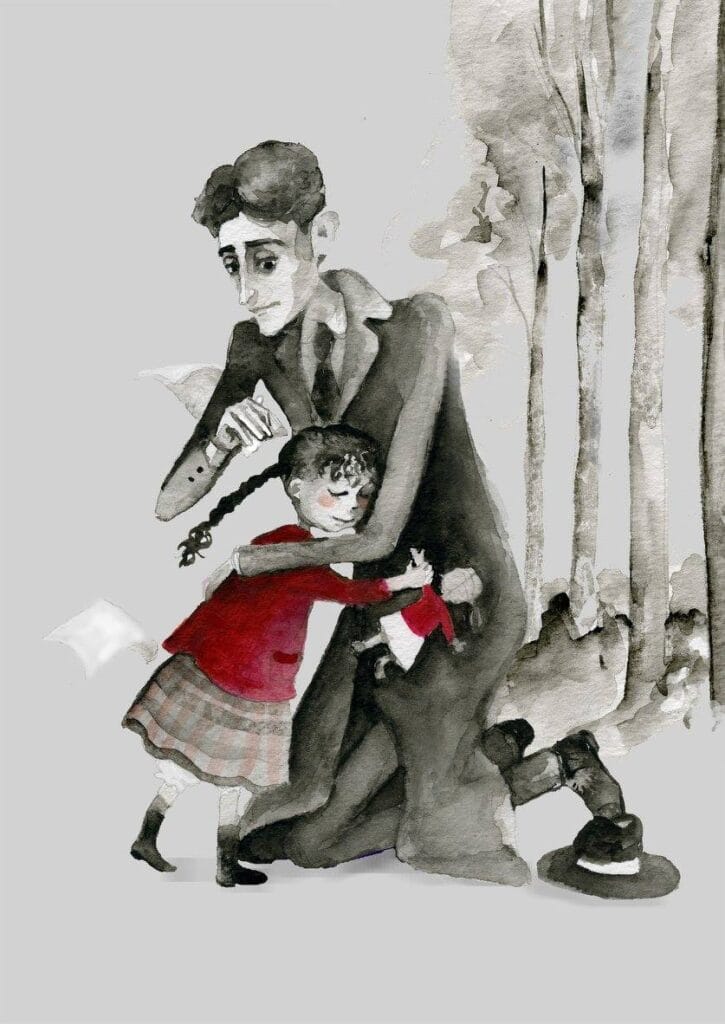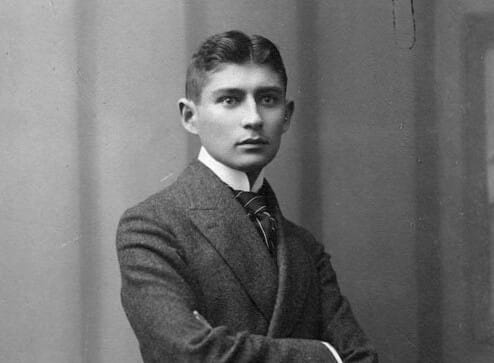A touching story is popular on the Internet: supposedly the Austrian writer Franz Kafka met a girl who had lost a doll, and for weeks he wrote letters to her on behalf of the toy to console her. We decided to check if anything like this had actually happened.
On educational And entertaining websites, as well as on social networks (“VKontakte", X, Facebook*, Instagram*, Threads) and blogs (LiveJournal, "Zen") you can often find a life-affirming story: supposedly Kafka, while walking in the park, met an inconsolably sobbing girl who had lost her doll. The writer tried to find the toy, but to no avail. The next day he came to the park again and handed the girl a letter he had written on behalf of that same doll: supposedly she had gone on a trip, but promised to write to her owner. For some time, Kafka brought the girl more and more messages describing the doll’s adventures. After some time, he gave the child a new doll, and when the girl objected that it was not at all like the old one, the writer handed her a note that said: “Travel has changed me.” Many years later, after Kafka’s death, the matured owner of the doll allegedly found a letter hidden in the toy with the phrase “Everything you love will most likely be lost, but in the end love will return in another way!” The story is also found on literary portals and resources dedicated to children.
During life Franz Kafka was not such a famous and successful writer as he became posthumously. Moreover, unlike many prominent figures who failed to gain recognition from their contemporaries, Kafka did not strive for it. He was extremely reluctant to publish his works, so only a few collections of short prose were published during his lifetime. His most significant books - the novels “The Castle”, “The Trial”, the story “Metamorphosis” - were published after the writer died of tuberculosis in 1924. Before his death, he bequeathed to his friend, writer and critic Max Brod destroy all unpublished manuscripts and do not republish anything that has already been published. Brod was convinced of the exceptional importance of Kafka's literary works, so he published all the previously unpublished manuscripts, as well as several biographies of the writer.
In 1939, Brod moved to Mandatory Palestine - this is how Kafka’s manuscripts came to Israel and were nationalized in 2018 and transferred to the country's national library. The Israeli authorities spent many years suing the descendants of Brod's assistant Esther Hoffe, who received the manuscripts after his death. The Hoffe family considered them their property and, years before nationalization, managed to sell some of Kafka's documents to private collections.
Some of Kafka's manuscripts, as well as letters and diaries, were kept by his beloved actress Dora Diamond. Unlike Brod, at the request of the writer, she still burned part of his literary heritage, but she still had about 35 of his letters and 20 notebooks of his diary entries. In 1933, her Berlin apartment was raided by the Gestapo, the papers were seized and disappeared. Non-profit volunteer organization Kafka Project still trying to find these documents. It turns out that, despite the fact that part of Kafka’s legacy has been studied and digitized, this is far from an exhaustive list of texts from his pen.
The "Verified" story being circulated could not be found in Kafka's published works. Nevertheless, the original source was very close to the writer: for the first time about “puppet” letters in his memoirs, published in 1948, told Dora Diamant, with whom the writer spent the last year of his life. Walking with his lover in the park, Kafka, according to Diamant, actually met an inconsolably sobbing girl who had lost her doll. To calm her down, he told her that the doll was not lost at all, he had just seen it at the station: she asked the owner not to be upset and even handed over a letter that the writer promised to bring to the girl the next day. The next day he actually came to the park with a letter, and then met with the girl again and again, handing her letters on behalf of her lost toy, which described the doll’s adventures. In these notes, he said that the doll missed its owner terribly, but could not return, as she was busy with her toy affairs. According to Diamant, Kafka did not know how to end this correspondence without upsetting the child, and in the end he decided to write that the doll had gotten married, so she could not return to her former life. There is no mention of any doll purchased to replace the lost one in Diamant's story.

However, Max Brod in his biography “Despair and Redemption in the Works of Franz Kafka” gives a slightly different story, but also refers to the fact that he learned it from Diamant. In his version, Kafka corresponded with the girl on behalf of the doll until he had to leave Berlin for health reasons. Then he bought the child a new toy, explaining that traveling had changed her. This version is closer to the one that went viral on the Internet, although Brod also does not mention the part in which the grown-up girl finds a note hidden in the doll. However, in order to write about this, Brod at least had to know this woman, and there are some difficulties with this.
Researchers of Kafka’s life and work have not yet been able to find either the originals of those letters or the girl addressee. One of the most notable attempts to find out anything about this story and its supposed heroine undertook in 2001, American literary critic Mark Harman, who was working at the time at the American Academy in Berlin. Even about his search wrote several large German newspapers, however, Harman did not find any traces. But this does not mean that the story is fictitious: the girl herself, for example, might not have lived to see the moment when Diamond told about this incident. In addition, as already mentioned, during his lifetime Kafka was not a celebrity, so the girl might not attach much importance to this episode from her childhood and would not tell anyone about it. The key episode of the story as presented by bloggers and authors of publications on entertainment sites is a note allegedly found years later. However, researchers never found the same girl, so this detail is most likely completely fictitious.
Fact checkers of the Snopes project also researched a widely circulated story about Kafka's “puppet” letters. They concluded that for the first time, a phrase from a note allegedly found by the girl years later (“Everything you love will most likely be lost, but in the end love will return in another way!”) appeared in article psychotherapist May Benatar in Huffpost in 2011. She notes that there are many versions of this story, but this is the one Benatar heard from a friend of hers, a meditation teacher and psychologist. It is unknown where she got this information from. But in general, such metamorphoses of this story are not surprising, since the plot has been encountered more than once not only in studies dedicated to Kafka, but also in fiction, enriched with colorful details.
For example, the American writer and translator Guy Davenport dedicated one of the stories to this story in the collection “Table of green fields", published in 1993. In Belinda's Trip Around the World, he retells the story of Kafka's meeting with a girl who had lost her doll, and then provides several specific texts from letters in which the toy describes its incredible adventures to the girl. In the last letter, the doll says that she is getting married and invites the girl to visit her and her husband in Argentina. In the collection's notes, Davenport explains that he came across the story of the doll's letters in a biography of Kafka edited by Ronald Heyman. And his story is a recreation of these supposed letters.
Thus, at the moment, researchers have not been able to find either the alleged letters themselves, or the girl to whom Kafka wrote them, or even her relatives who could confirm this story. For the first time, the writer’s lover spoke about her, who, according to her, was personally present both at Kafka’s meeting with the crying girl and at the creation of the “puppet” letters. The original letters could indeed have been lost or destroyed, like much of Kafka's written legacy. Therefore, at the moment it is not possible to either confirm or refute this story: it could be either a real or a completely fictional Dora Diamant. However, the fragment about how a grown-up girl found a note in a doll years after Kafka’s death is apparently completely fictitious - since no one found that same girl, there would also be no one to tell about this amazing find.
Cover photo: Atelier Jacobi: Sigismund Jacobi (1860–1935), Public domain, via Wikimedia Commons
*Russian authorities consider the company Meta Platforms Inc., which owns the social networks Facebook and Instagram, to be an extremist organization; its activities in Russia are prohibited.
Read on the topic:
- Snopes. Did Franz Kafka Invent Letters from a Missing Doll to Comfort a Little Girl?
- Is it true that Guy de Maupassant regularly dined at the Eiffel Tower, just so as not to see it?
- Is the mystical story about the correspondence of the writer Yevgeny Petrov true?
If you find a spelling or grammatical error, please let us know by highlighting the error text and clicking Ctrl+Enter.






